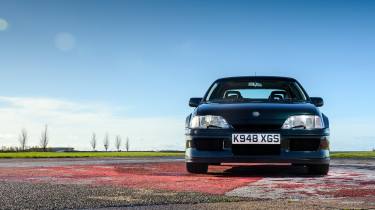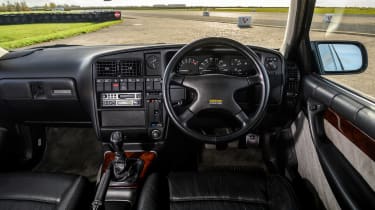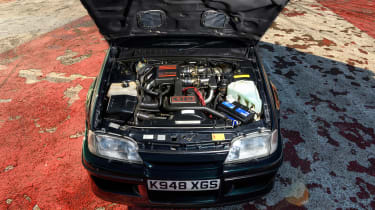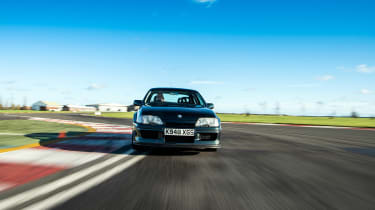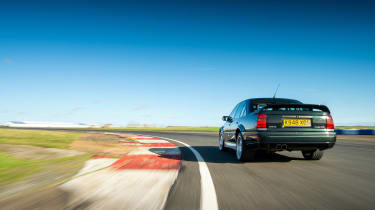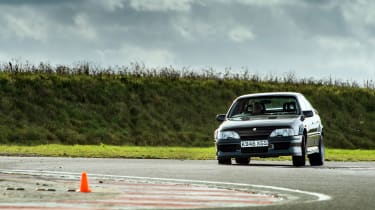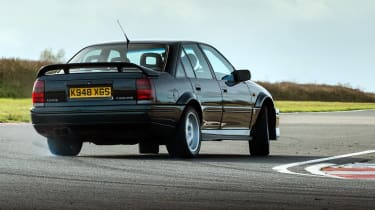Lotus Carlton – history, review and specs of an icon
The 176mph Lotus Carlton was a legend in its own lifetime, but how does it stack up 30 years later?
After the next few days, K984 XGS will head into retirement, its active life on Vauxhall’s heritage press fleet reduced to an ambassadorial role, to be dusted off for special occasions and the odd anniversary. Yet it’s hard to see when those special occasions will materialise. With Vauxhall now part of the vast Stellantis group – the fast-growing European-American conglomerate that will build everything from a £6000 electrified Citroën Ami to an 800bhp Dodge Hellcat – its future looks secure. But while the Hellcat might have a certain synergy with a 377bhp supersaloon that factions of the British press wanted banning 30 years ago, I’m not holding out much hope that Vauxhall is working on a 21st century remake of the Lotus Carlton. I doubt many are.
The supersaloon genre was nothing new by the time GM started transferring money from its Vauxhall bank account in Luton to Lotus’s account in Norwich. BMW, Jaguar and Mercedes had all offered examples of fairly ordinary-looking executive saloons with larger-than-life motors installed behind their corporate faces. But generally speaking they didn’t shout about their credentials, which was just the way most customers liked them. The Lotus Carlton was different.
It’s an alluring beast when you first see it, parked alone in the shadow of what is now Vauxhall’s defunct UK headquarters. There’s a security hut with a camera aimed at XGS’s green bodywork, and the gentlemen inside are aware this will be the last time they’ll hand over its slim key and ask for a signature in return. I tell them I’ll be back before 5pm on the day we’re due to return it. ‘Don’t worry, sir, we’ll be here all night. Make sure you enjoy it and get a good drive…’ Just as Griffin House will soon be whatever white elephant its new owners think investors will want to lose money in, the security guards know their days of being custodians to cars such as XGS are numbered, too. Time moves on.
The clunk of the Carlton’s central locking could only be from the ’90s. Old-school mechanicals meeting seemingly day-old electrical tech. Your fingers slip under the handle; you’re caught out by the lightness of the driver’s door as it swings open, then stopped in your tracks by the sight of the large, ruched leather armchairs. I’d forgotten about these. I didn’t expect M5 CS-style carbon-backed buckets, but having spent three decades devouring as much LC content as possible, the chairs had been pushed into the recesses of my grey matter. They look comfy though, if lacking in support for a car with the power-to-weight ratio of a Civic Type R.
More reviews
Group tests
- Alpine A290 v Alpine A110 – how much DNA do they really share?
- Ariel Atom 4R v Caterham Seven ‘evo25’: power-to-weight heroes go head-to-head
- Caterham Super Seven 600 v Super Seven 2000
- Levante v T1
- Corvette Stingray v Porsche Cayman GTS v Audi R8 RWD
- Great Ferrari hypercars driven: 288 GTO, F40, F50 and Enzo head-to-head
- Hardcore Ferrari V8 specials go head-to-head
- Lamborghini Aventador Ultimae v Lamborghini Countach
- Lotus Emira v Morgan Plus Four – four-cylinder Brits go head-to-head
- Toyota GR86 v BBR Mazda MX-5: supercharged drop-top battles sports coupe
In-depth reviews
- Abarth 600e 2025 review – Italy gives the Alpine A290 something to worry about
- Alpine A110 review – distinctive, lightweight and unforgettable to drive
- Audi R8 (2015 - 2024) review – the ultimate soft-focus supercar
- Bentley Continental R Mulliner: review, history and specs
- BMW 5-series review – is this still Munich’s anchor model?
- BMW 1-series review – Munich’s Audi A3 rival gains focus
Long term tests
- Abarth 695C Turismo Fast Fleet test – 10,000 miles in the Italian hot hatch
- Alfa Romeo Giulia Veloce Fast Fleet test – 7000 miles in the sharp Italian saloon
- Alpina B10: end of term report
- Alpina B10
- Ford Mustang GT
- Ford Mustang GT
- Ford Mustang GT
- Land Rover Defender 110 Fast Fleet test – 9000 miles in the go-anywhere SUV
- Maserati Ghibli Trofeo Fast Fleet test – 4000 miles in the Ferrari-powered saloon
- Mitsubishi Evo MR 340
Review
- New Aston Martin DBS 770 Ultimate review – 759bhp super-GT driven
- New Bentley Batur 2023 review – can it possibly be worth £1.65m?
- 2023 Chevrolet Corvette C8 Z06 review – the American 911 GT3?
- Kia EV6 GT-Line S prototype review – the EV that shows how it’s done
- BBR Supercharged Mazda MX-5 (ND) 2023 review – tuned 250bhp roadster driven
- MG4 Trophy 2023 review
Reviews
- Abarth 695 75 Anniversario edition 2024 review – a fitting send-off for Abarth’s hot supermini?
- Abarth 500e 2023 review
- AC Cobra 378 Superblower MkIV 2021 review – another V8 Cobra, but with a GM heart this time
- Acura Integra Type S 2024 review – a Honda Civic Type R with added restraint
- Alfa Romeo Giulia 2025 review – get one while you still can
- Alfa Romeo SZ: history, review and specs of an icon
- Alfa Romeo 1750 TBi
- Alpina B3 GT Touring 2025 review – a 190mph alternative to the BMW M3 Touring
At the time, producing such a bespoke high-performance car based on a volume model was both mind-scramblingly complex and fiercely expensive. So while BMW approached the task in the manner only BMW could, by establishing M GmbH, others were a little less detailed in their planning, whether it was Ford requiring the services of Tickford to build its Cosworth models or Vauxhall making the call to Hethel. Cars such as the Lotus Carlton would never make it beyond idle chat over a latte today. Some probably think they shouldn’t have gone much further back then, either. But thankfully they did.
> Lotus Carlton vs Vauxhall GTS-R
The process required to build 949 Lotus Carltons (or 950 if the last car genuinely did make it off the line without being damaged) still makes the teeth of project managers and accountants itch today. Opel’s Russelsheim plant built the Carlton 3.0 GSi donors and when there were enough to fill a transporter they’d head across the North Sea to arrive at Hethel to be ripped to pieces. The body was cut to accommodate the blistered arches, the transmission tunnel modified to allow the six-speed gearbox to fit. Suspension, brakes, engine, gearbox, exhaust… all came off and were either put to one side or sent off to be rebuilt while the LC’s bumpers, bonnet, bootlid and spoiler were attached for the car to be painted once again.
Even in the early ’90s, cars were designed to be built by machines in a very orderly manner and rarely responded well to being stripped and put back together – unless done to a standard so high that the end result was nothing short of a hand-built car. Which is what the LC was – and still feels today, three decades on.
I pause before turning the key in the ignition barrel. This is a defining moment for someone who grew up idolising a four-door saloon car that, on paper, made supercars look lethargic. It’s possibly a little far-fetched to say that the Lotus Carlton, and cars of its ilk, made supercar manufacturers up their game, but if you could buy a saloon car that was as quick in a straight line, handled, and was built to a higher standard than anything low, wide and costing nearly double the price, why would you send another chunk of cash to Maranello for a 348?
> Lotus Calton vs BMW M5 (F10)
Well, the soundtrack might be one reason. ‘Industrial’ would be the best way to describe the sound of the turbocharged straight-six, which is a little surprising when you know that the work carried out to transform the 3.0 GSi’s naturally aspirated six into the LC’s 3.6-litre twin-turbo was far more involved than squeezing some larger pistons into the cylinders. Lotus designed all the upgrades for the engine, reinforcing the webbing of the block and specifying a stronger crankshaft that was originally to be milled from solid billet by a specialist in Italy though production cars received machined items from Germany. While the four-valve cylinder head was left largely untouched, the combustion chambers were milled to reduce the compression ratio, while Mahle manufactured the pistons to Lotus’s own design and specification, along with the connecting rods. Two Garrett T25 turbos were selected, along with an intercooler that halved the charge temperature from 120 degrees, and the ignition and injection systems were bespoke to the car.
At tickover it’s not uncouth as such, but there’s little in the soundtrack to hint at what’s available under your right foot, which at 377bhp and 419lb ft completely overshadowed BMW’s contemporary E34 M5 (335bhp and 295lb ft). The initial response might have you thinking the throttle cable has stretched since nothing much happens at the first press of the pedal, but once you’re rolling and revs begin to build, the responses and appetite to gain momentum are just what you’d expect from a saloon conceived to be the world’s fastest.
You’re soon working the ZF six-speed manual, a donation from GM’s Corvette ZR-1. It’s unmistakably from an era when strength came much higher up the list of requirements than finesse, but in a short time the lever is flowing around the gate, not exactly snicking home but every ratio is where your instincts suggest you will find it. Third to fourth is a sweet spot, blending the engine’s torque with its power delivery as the lever slides back and into place with a satisfyingly mechanical feel, your brain ready for what’s coming as your left foot comes off the heavy clutch, the turbos spool and you add speed at a rate more in keeping with today’s hyper-hatches than a 30-year-old saloon with plastic interior wood trim.
Experience this hit just once and you’re hooked. The LC’s performance is monumental, your self control sorely tested. What’s more, despite the weight to the controls, you can be remarkably delicate with it, building a real flow and a rhythm, leaning on the AP brakes deep into a corner before setting a balance across the Carlton’s Lotus-developed multi-link suspension. There’s some body roll – an alarming amount by today’s standards – but when it settles there are no spikes to watch for or traps to catch you out. The rear diff, sourced from the Holden Commodore, feels a little loose on this example, but you can rely on it to find strong drive out of any given corner, hooking up quickly when you feed the power in once you have the nose locked on line.
A little more speed and quicker reactions from the Senator power steering system wouldn’t go amiss, but it’s a 30-year-old car and today it still feels alive, exciting and bursting with character. Yes, you sit too high, and for all its bulges, vents and spoilers on the outside, the inside feels like a model of restraint. Yet it remains a truly wonderful place to be as that straight-six awakens, another gear lands home and you ride a cresting wave of power and torque towards the horizon.
We couldn’t let our last drive in XGS go by without a visit to Bedford Autodrome. The LC was born before a time when every new performance car had to prove its credentials on track with a lap time that could headline the marketing offensive. So there’s no Vbox today, just a short window to sample the LC with fewer restrictions than we have on the road. An opportunity to stretch the straight-six one last time, get some serious heat into those APs and ask the Lotus-honed chassis to demonstrate what Vauxhall got for its money all those years ago.
This is where the illusion could go so horribly wrong. A 30-year-old car floundering around a track as an Octavia vRS looks for a way past. But it doesn’t. Out of the hairpins the LC gallops to the next braking point as if someone has wound the clock back to 1991; second, third, and fourth pass in a blink, and speeds are reached that would put some very modern machinery in some very dark shade. Every time I look down it’s doing 130mph. It’s what I expected. No, it was what I wanted it to be. Fast beyond expectations. This was a hero car back in the day – and it proves it still is.
It doesn’t fall over itself at the first sign of an apex, either. Sure, you need to recalibrate your inputs, start the process slowly, turning in sooner than you would in something ten years newer, let alone a car from the present day. But, once settled and locked, the LC demonstrates a finesse and a character that’s hugely enjoyable and likeable, its DNA rushing to the surface, wanting you to experience it as best you can.
A healthy layer of dark dust on the deep-dished five-spoke alloy wheels is a very clear signal that perhaps it’s time to call it a day and head back to Luton one more time. There are two routes from here to Vauxhall’s old HQ, the dull route and the evo route. And for 45 minutes the LC shines once again, as happy to lope along in the high gears, surfing that wave of torque, as it is to race around its lower ratios and fire you out of a corner as quickly as it got you there. With every mile a bit more of the Lotus Carlton gets under your skin. If you’re a fanboy (have you guessed that I am?) it does everything you wanted it to do from the moment you first saw it on the printed page and read about this four-door Vauxhall saloon car that was faster than just about anything else on the road.
And it still holds its own today, because while that 176mph top speed gave everyone a focus, the bigger picture is that what started life as a humble executive saloon was transformed into a great driver’s car, one whose icon status is undimmed.
The same two security guards are on duty on our return. I hand them the keys but little is said between us; they seem to know that the last few days have been the right kind. Like me, they know that for K984 XGS there might not be many, if any, more like them. And that would be a travesty, because cars this good shouldn’t be left in a museum.
Specs
| Engine | In-line 6-cyl, 3615cc, twin-turbo |
| Power | 377bhp @ 5200rpm |
| Torque | 419lb ft @ 4200rpm |
| Weight | 1658kg |
| Power-to-weight | 231bhp/ton |
| 0-60mph | 4.8sec |
| Top speed | 176mph |
| Price when new | £48,000 |
| Value now | £45,000 |
| evo rating | 5 |
This icon feature was first published in evo 292. Click here to purchase the latest copy or subscribe

